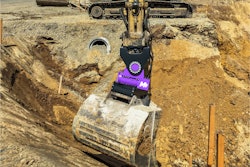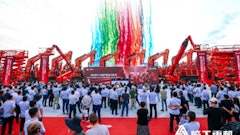
With the Internet age well upon us, the need for paper continues to decline. So naturally, paper manufacturers haven't fared especially well in recent years. While it's highly doubtful the world will find itself completely paperless anytime soon, there's already been enough of a shift to put plenty of players in the paper industry out of work.
It's been an especially unpredictable last 10 years for the old Champion paper mill in the Houston suburb of Sheldon, Texas. But there's nothing uncertain about its fate any longer, now months into a lengthy multi-million dollar demolition project to dismantle the decades-old facility.
With its long history almost completely written, the Sheldon mill had nowhere to go - but down - when Utah-based Grant Mackay Demolition Co. arrived on scene with a 12-man wrecking crew in September 2008. The contracting firm, in business since 1983, is no stranger to large-scale demolition jobs, although this was the company's first assignment in the state of Texas.
"We primarily work in the intermountain area - Idaho, Wyoming, Utah and a few other states in the Southwest," says Grant Mackay, owner of Grant Mackay Demolition. "Our main thing is demolition, although we also do some excavation and construction work. Over the years we've worked our way up to where now we have about 100 employees and anywhere from 10 to 20 jobs going at one time.
"We tackle some pretty big jobs, including the Geneva steel plant demolition in Utah a few years back. One of the financers on that project was involved with the site here in Sheldon. They were pleased with what we did at Geneva and called us in to submit a bid."
All totaled, the Sheldon complex covered around 1.5 million square feet. In addition to asbestos abatement and interior demolition of the main buildings that had housed workers and newsprint manufacturing while the mill was operational, the project involved a fair amount of high reach work, including the removal of a 100-foot-tall power plant. Several tanks and other miscellaneous structures also posed some height-related challenges.
"Typically we handle high reach demolition work with a hydraulic attachment, rather than putting people in risky, elevated situations," says Mackay. "Our primary high reach machine and processor were tied up on a mall demolition job in Salt Lake City, so we decided to purchase new equipment to help take down the paper mill."
Grant Mackay certainly needed an attachment with ample cutting power to keep the job moving, but the company also knew the attachment needed to be as lightweight as possible. Too much weight would make it difficult for an excavator to safely elevate the attachment to the extreme heights of the tallest structures.
Mackay contacted Rasmussen Equipment Company, a local dealer from its home territory, and purchased a new Link Belt LX 700 high reach excavator, a machine with extended booms designed to reach heights of up to 110 feet. To complement the excavator, Rasmussen also sold Grant Mackay an Atlas Copco CC 3300 Combi Cutter, an attachment that offers a maximum cutting force of 441 tons.
"We decided on the Combi Cutter because it's a very lightweight unit when you consider how powerful it is," says Mackay. "And that lower weight has allowed us to attain a higher reach than would have been possible with a heavier, bulkier attachment."
The CC 3300 weighs 7,320 pounds when equipped with steel-cutting jaws and 7,670 pounds when using universal jaws for crushing concrete. "It's being used to facilitate the more substantial demolition of the taller structures so we can get them down to more manageable heights," says Mackay. "It's cracking concrete in some areas and cutting steel in others. Fortunately we're able to transition between cutting jaws very quickly when necessary."
Thanks to a single-pin retention design, the CC 3300's jaws can be changed out in about a half hour in the field. The same task can take several hours with other attachments on the market, a fact that even plagued previous Combi Cutter iterations from Atlas Copco. With the single-pin arrangement greatly expediting the jaw-changing process, the CC 3300 offers practical flexibility to tackle whatever tasks it's needed for in a timely fashion.
"It's extremely versatile," says Mackay. "In addition to cutting the actual structural steel, we used the attachment to separate some tanks that were connected by a series of pipes running across them. The Combi Cutter just sliced through the pipes and really made quick work of getting those tanks freed up."
Quick work is exactly what Grant Mackay Demolition needed out of the CC 3300, given that it's the only high reach tool on the site. Fast and efficient operation of the attachment is aided by a hydraulic drive that allows the unit to rotate a full 360 degrees, allowing for excellent maneuverability and accurate positioning. Two powerful hydraulic cylinders with speed valves also help to shorten cycle times.
"The cycle times are impressive," says Joe Christensen, project manager on the Sheldon mill job. "The jaws can really complete a cut smoothly and then are open and ready to cut again in just a few seconds. That's very helpful for keeping us going at a steady pace and on schedule."
Grant Mackay is well on track to meet the July 2009 deadline for project completion, thanks in large part to the CC 3300's durability. "We've experienced a lot of downtime in the past with some different attachments," says Mackay. "I like the way the Combi Cutter is designed so that the cylinders are protected. The actual chrome on the cylinder can't get scratched up. That's something we had problems with previously on our older equipment, and it led to some pretty significant repair costs."
Mackay also attributes equipment reliability to the service and support his company has received from Rasmussen Equipment. "They've been great for us, starting with making the necessary adjustments to get the attachment flowed properly," says Mackay. "Both their salesmen and service department have been very attentive to our needs."
After its high reach responsibilities at the mill have been fulfilled, the CC 3300 will continue to assist with secondary reduction tasks, including cutting steel beams on the ground. By the time the job is done, more than 30,000 tons of steel and another 30,000 tons of concrete from the various structures at the Sheldon facility will have been removed and processed. The steel will be sold off, while the concrete will be recycled and used in the re-development of the Sheldon property into an industrial complex for warehouses, contractors and other businesses.
Only time will tell if the new tenants of the site will fare any better than the Sheldon paper mill did in its final years. As for Grant Mackay Demolition, the early returns seem to indicate that the company will be getting some very productive years out of its Combi Cutter attachment - and that's no reach.


















